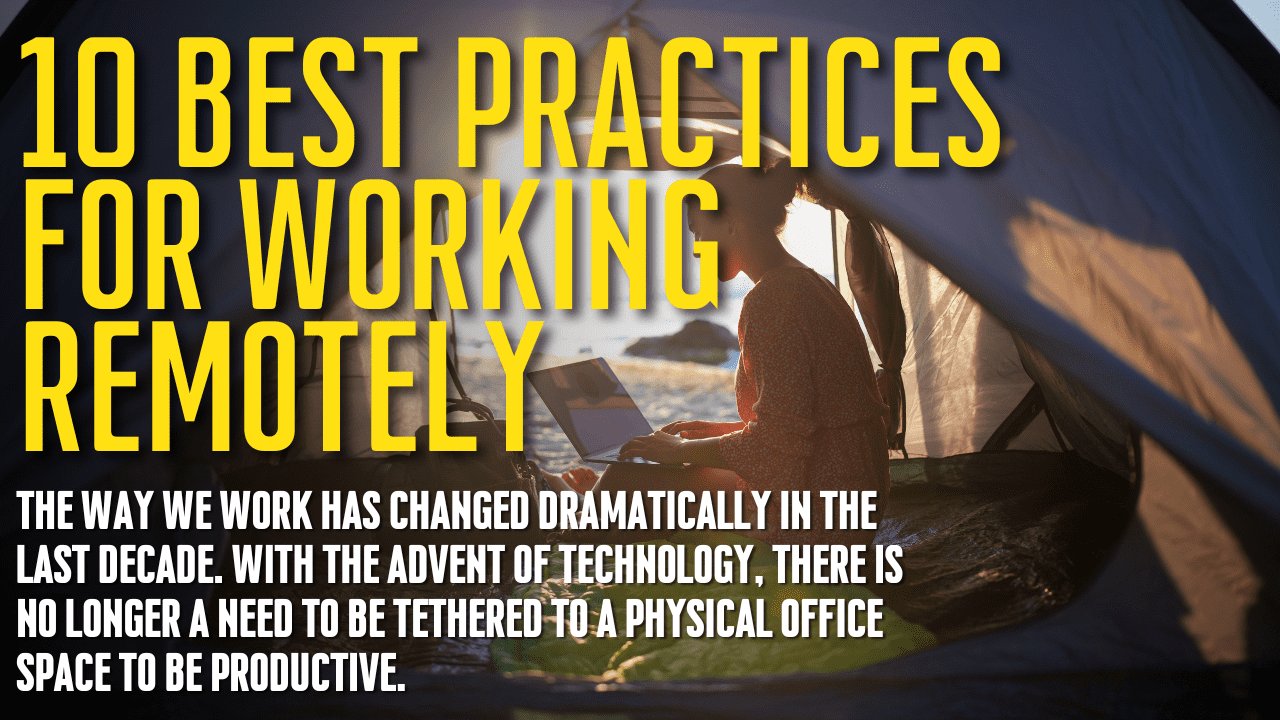10 Best Practices for Working Remotely
Key Points:
- Working remotely is not going anywhere and will become increasingly popular as time goes on.
- It is important to know the potential security risks when working remotely and take steps to mitigate those risks.
- Maintaining a secure remote working environment begins with the right tools and processes.
The way we work has changed dramatically in the last decade. With the advent of technology, there is no longer a need to be tethered to a physical office space to be productive. Instead, more and more people are finding that they can work remotely, either from home or in various locations. Working remotely has many advantages, including increased flexibility and freedom, but some challenges come with it.
Cybercriminals are always looking for new ways to exploit vulnerabilities, and remote workers can be an easy target. Maintaining a secure remote work environment is vital to protecting your company’s data and keeping your confidential information safe. Before maintaining a secure remote working environment, it is important to understand the potential risks.
Here are 5 of the most common security risks for remote workers:
1. Unsecured Networks
One of the most common risks for remote workers is using unsecured networks. When you connect to an unsecured network, you are giving hackers an easy way to access your data. To mitigate this risk, only connect to networks you trust and ensure your device is up-to-date with the latest security patches.
2. Malware and Phishing Attacks
Another common risk for remote workers is malware or phishing attacks. These attacks can happen when you click on a malicious link or attachment or visit an infected website.
To protect yourself from these attacks, be careful about the links and attachments you click on and only visit websites you trust. If you think you may have been infected, run a virus scan on your device as soon as possible.
3. Unencrypted Devices and Data
If your device is lost or stolen, it’s important to ensure your data is encrypted. Otherwise, anyone who gets their hands on your device can access your data.
4. Weak Passwords
One of the most common security risks is weak passwords. Hackers can easily guess weak passwords, so choosing strong, unique passwords for all your accounts is important.
To create strong passwords, use a mix of letters, numbers, and symbols. Avoid using easily guessed words like your name or birthdate. Never reuse passwords across different accounts.
5. Lack of Security Awareness
Even if you have all of the right security measures in place, they won’t do you good if you don’t know how to use them. That’s why it’s important to have security awareness training for all remote workers.

10 Best Practices for Working Remotely
Now that you know about some of the most common security risks for remote workers let’s look at 10 best practices for maintaining a secure environment.
1. Keep Your Software Up to Date
It’s important to keep all of the software on your device up-to-date, including your operating system, web browser, and any applications you use. Software updates often include security patches that can help protect you from newly discovered threats.
2. Use Two-Factor Authentication
Two-factor authentication is an extra layer of security that requires you to confirm your identity with two different factors: your password and a code sent to your mobile phone.
3. Implement BYOD Policies
If your company allows employees to bring their own devices (BYOD), it’s important to have policies to secure them. Make sure employees understand the security risks and know how to protect their data.
4. Use a VPN
One of the best ways to protect your data when working remotely is to use a Virtual Private Network (VPN). A VPN encrypts your data and routes it through a secure tunnel, making it much more difficult for hackers to intercept.
5. Educate Your Employees
As we mentioned before, security awareness training is critical for all employees, especially those who work remotely. Employees should know how to identify security risks and what to do if they suspect their device has been compromised.
6. Migrate to the Cloud
There are many benefits to migrating to the cloud, including increased security. When you store data in the cloud, it’s stored on secure, regularly backed-up servers. You can still access your data from another device if your device is lost or stolen.
7. Use Security Tools
There are a variety of security tools available that can help you protect your data. Some common tools include firewalls, anti-virus software, and intrusion detection systems.
8. Monitor Your Network
If you have a remote network, it’s important to monitor it for suspicious activity. There are a variety of tools available that can help you do this, including network intrusion detection systems and log monitoring tools.
9. Restrict Access to Data
You should only give employees the access they need to do their jobs. For example, if employees don’t need access to certain sensitive data, they shouldn’t have it. This will help reduce the risk of data breaches.
10. Regularly Back Up Your Data
It’s important to regularly back up your data in case of a security breach. You can do this in various ways, including storing data in the cloud or on an external hard drive.
Wrapping Up
Digital transformation has changed how we work, and remote work is here to stay. Given the rise in remote work, it’s important to be aware of the security risks and take steps to protect your data. Remember, security risks can come from anywhere, not just external hackers. Disgruntled employees, for example, could wreak havoc on your company’s systems if they decided to take advantage of their access privileges. So it’s important to have policies and procedures to mitigate employee risks working remotely.



